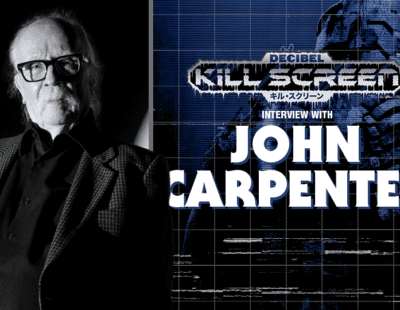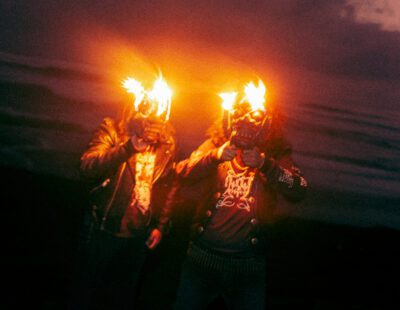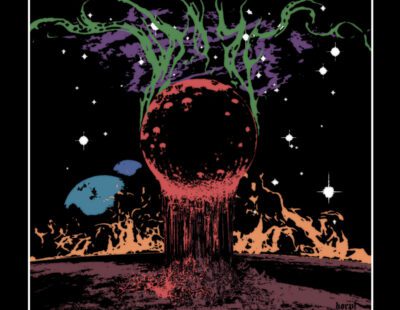Rituals are a dime a dozen. Any greasy-haired jabroni with a couple half-baked tremolo riffs and a motheaten cloak can stage a ritual; extra points if he cops a wood-burning kit for Christmas and goes to town on some dirt from outside his grandma’s prayer meeting to accent the seven copies of his upteenth Garageband demo. Asking his friend from down the block with the half-tuned bass to join the band? Initiation ritual. Begging his artsy little brother to draw some skulls and shit for a demo “cover”? Visualization ritual. Spamming his cousins with Facebook invites to yet another crappy local show, where his band will be the first of seven to play? Summoning ritual. He comes home from school and has a few pages of Shakespeare to slog through before ma will let him plug in the ol’ guitar? Homework ritual. The word has largely lost its meaning, at least where extreme metal jargon is concerned. Yet, sometimes, if we’re lucky, the scales drop from our jaded eyes and we’re able to witness something that cannot be described as anything but an honest-to-gosh ritual.
Vemod’s performance on April 19th at the Emanuel Vigeland Mausoleum in Oslo, Norway during this year’s Inferno Festival was one of those. What happened within the mausoleum that day was unquestionably a ritual. It was a spiritual, complex experience that drew its scant attendees close and took our breath away. You know how when you’re little, and you’ve been raised up Catholic, and you get dragged to Mass for the first time, and somewhere in between the sweaty knees and charlie horses, you catch a fleeting sense of something greater? This felt like that, only it lasted nearly an hour, and felt a thousand times greater.
There were only thirty of us there. We’d been bundled over into a pair of vans and deposited outside a looming structure smack dab in the middle of one of Oslo’s leafy, affluent neighborhoods. After a short talk about the building, we ventured inside and took our seats. The mausoleum itself had been built by Norwegian artist and all-around badass Emanuel Vigeland, who employed techniques used in the painting of the Sistine Chapel to create one hell of a final resting place for himself. The structure takes the form of a small windowless church, with walls covered by a sprawling fresco depicting scenes of birth, life, love, and death in all their fearsome glory. The lights are kept low, so as you walk in your eyes are forced to adjust to the gloom. The acoustics inside the joint are insane – a single tap of your boot rise and echoes throughout the entire building, and speaking above a whisper feels like it’s seconds away from inspiring a Lion King-style wildebeest scenario. An urn containing his ashes sits above the low doorway, effectively forcing visitors to bow before him as they leave (one assumes his brass balls are preserved in there, too). It’s an impressive enough experience to simply walk into this place, but we were there for something even more intense: a special ambient performance from Norwegian atmospheric black metal masters Vemod.
I’m a little glad they went the acoustic route, because the thought of a blastbeat ricocheting wildly off those high walls makes me feel a bit ill. As it was, the experience we were invited into was wholly overwhelming in an entirely different way. There were occult elements throughout, from the burning incense to the pouring of liquid and candles littered throughout the space, but it still felt profoundly spiritual. Vemod only has two core members but had brought in a couple live musicians to aid in their performance on the main stage yesterday. That day, three men stood before us, slick and solemn with their suits and clipped haircuts, looking more like choirboys than shamans. The music itself was sparse, with a simple drum, muted electric guitar, and wind chimes making up the bulk of the instrumentation. The true power lay in the vocals, which saw the three men trade off chanting alone and in harmony. Bandleader J. E. Åsli’s sonorous voice often rose up until it filled the room, the acoustics rendering it nearly godlike as it rippled across the walls. The audience was rapt, lulled into a trance that was only broken only when, forty-odd minutes later, the flames were extinguished and silence crept back in.
I grabbed J. E. Åsli for a quick chat just as the hall was emptying out, and he gave me a few shreds of insight into what we had just witnessed.
What was going on in the ritual you performed at the very beginning?
JEA: It’s basically a banishing ritual to clean the space, to focus our thoughts and intentions to the max for the performance, to gather focus, and for the audience to know what they are a part of.
And what was happening when you did it again at the end?
JEA: We opened the gates of the rest of the world again.
What made you decide to include these rituals into the performance?
JEA: “t came very natural, we’ve wanted to have some sort of ritualistic introduction and conclusion to the set which was specially made for this
Inferno put this whole thing together, right?
JEA: Yes, this was the idea of inferno. We got the offer at the same time as for the regular show, and we said yes because this was a great opportunity for us to do something different.
Of course you sounded quite different when I saw you on stage yesterday. Your guitarist was telling me about how you guys have been experimenting with ambient music and performances since Vemod began. How does your interest there fit into the band’s black metal side?
JEA: For me it’s different sides of the same coin. The atmosphere is what we focus on with this band, it’’s atmospheric music overall, and for me, for us, it’s really the same kind of feeling that we try to bring forth with this kind of music and the kind of music we performed yesterday. It’s different but still the same threads of atmosphere and emotion.
The quality of your voice is astonishing. Are you a trained singer?
JEA: In Norway when we are in high school, we can choose three years of a specialisation. I chose music, so we had the regular school and some music lessons on the side. I started on guitar then changed to vocals. So, i got singing lessons from 17-19 but that’s awhile ago now. I just need to sing a bit more to train myself again now that i have a purpose to sing. This is something that feels right for me; I don’t like to sing the songs of others, I want to sing my own songs.
There are lyrics printed in this little booklet they handed out as we walked in, but unless I’m mistaken, most of the time, you weren’t actually singing them – it was more of a wordless chant.
JEA: No, we didn’t really sing the words at all. They are really just for the booklet, to give people a sense of what we’re trying to express in the music. We didn’t sing any words except “Solve Coagula.” The words in there are atmosphere amplifiers.






